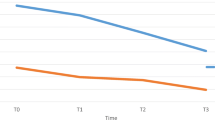Abstract
Defense mechanisms represent an important component of medical education that should be taught to all medical students, psychiatry residents, and other mental health trainees. Teaching about defense mechanisms can become more engaging by analyzing popular media. Using Breaking Bad, a well-known television show, we recommend specific scenes and episodes that can be used in teaching about defense mechanisms.
Similar content being viewed by others
References
Hyler SE, Moore J. Teaching psychiatry? Let Hollywood help! Suicide in the cinema. Acad Psychiatry. 1966;20:212–9.
Fritz GK, Poe RO. The role of a cinema seminar in psychiatric education. Am J Psychiatry. 1979;136:207–10.
Hyler SE. DSM-III at the cinema: madness in the movies. Compr Psychiatry. 1988;29:195–206.
Hyler SE, Schanzer B. Using commercially available films to teach about borderline personality disorder. Bull Menn Clin. 1997;61:458–68.
Wedding D, Boyd MA. Movies and mental illness. In: Using films to understand psychopathology. New York: McGraw-Hill College; 1999.
Welsh CJ. OD’s and DT’s: using movies to teach intoxication and withdrawal syndromes to medical students. Acad Psychiatry. 2003;27(3):182–6.
McNeilly DP, Wengel SP. The “ER” seminar: teaching psychotherapeutic techniques to medical students. Acad Psychiatry. 2001;25(4):193–200.
Lewis MA. From victim to victor: “Breaking Bad” and the dark potential of the terminally empowered. Cult Med Psychiatry. 2013;37(4):656–69.
Brownfield, P. The Writers Guild of America, West. http://wga.org/content/default.aspx?id = 4857; Retrieved August 16, 2013.
Datta V. Madness and the movies: an undergraduate module for medical students. Int Rev Psychiatry. 2009;21:261–6.
Gramaglia C, Jona A, Imperatori F, Torre E, Zeppegno P. Cinema in the training of psychiatry residents: focus on helping relationships. BMC Med Educ. 2013;13:90.
Freud A. The ego and mechanisms of defense. London: Hogarth; 1937 (Original work published 1936).
Gabbard GO. Psychodynamic psychiatry in clinical practice. 4th Edition. American Psychiatric Publishing. 2005.
Reiser MF. Are psychiatric educators “losing the mind”? Am J Psychiatry. 1988;2:148–53.
Harper G, Becker DF, Copans SA, Flaherty LT, Gharib K, Krasner AJ, et al. Committee on adolescence, group for the advancement of psychiatry. Being with the patient: the use of “clinical evidence”, reconsidered. J Nerv Ment Dis. 2013;20(9):813–7.
Dingle AD, Beresin E. Competencies. Child Adolesc Psychiatr Clin N Am. 2007;16(1):225–47.
Beresin E, Mellman L. Competencies in psychiatry: the new outcomes-based approach to medical training and education. Harv Rev Psychiatry. 2002;10:185–91.
Burke MJ, Campbell C, Dunstone D, Lamdan R, Levine R, Roman B, Rosenthal R, Waterman S, Sierles F, Brodkey A. Clinical learning objectives guide for psychiatry education of medical students. Association of Directors of Medical Student Education in Psychiatry (ADMSEP). http://www.admsep.org/Clinical_LO_Guide_Outline_Format_Nov_07.pdf. Retrieved March 13, 2014.
Benbassat J, Baumal R. What is empathy, and how can it be promoted during clinical clerkships? Acad Med. 2004;79(9):832–9.
Neumann M, Elizur A. Group experience as a means of training medical students. J Med Educ. 1979;54(9):714–9.
Functions and structure of a medical school. Liaison Committee on Medical Education. June 2013. rhttps://www.lcme.org/publications.htm. Retrieved March 13, 2014.
Gabbard GO. Theories of personality and psychopathology, from Sadock BJ and Sadock VA. Comprehensive textbook of psychiatry. Seventh Edition, Volume One. 2000; pages 584–585.
Laplanche J, Pontalis JB. The language of psychoanalysis. The Hogarth Press. 1973
Brenner C. An elementary textbook of psychoanalysis. Doubleday Anchor Books. 1957.
Disclosure
On behalf of all authors, the corresponding author states that there is no conflict of interest.
Author information
Authors and Affiliations
Corresponding author
Rights and permissions
About this article
Cite this article
Johnson, J.M., Beresin, E.V. & Stern, T.A. Using Breaking Bad to Teach About Defense Mechanisms. Acad Psychiatry 38, 716–719 (2014). https://doi.org/10.1007/s40596-014-0161-4
Received:
Accepted:
Published:
Issue Date:
DOI: https://doi.org/10.1007/s40596-014-0161-4



